Hyundai H-100 Truck 2012 Owner's Manual
Manufacturer: HYUNDAI, Model Year: 2012, Model line: H-100 Truck, Model: Hyundai H-100 Truck 2012Pages: 217, PDF Size: 9.37 MB
Page 131 of 217
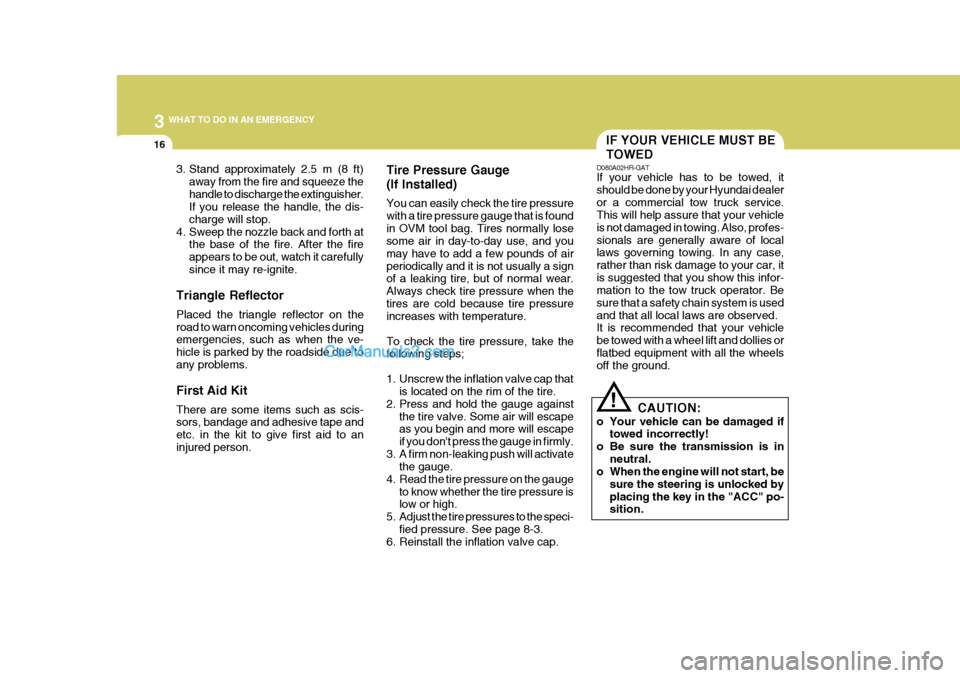
3 WHAT TO DO IN AN EMERGENCY
16
Tire Pressure Gauge (If Installed) You can easily check the tire pressure with a tire pressure gauge that is foundin OVM tool bag. Tires normally lose some air in day-to-day use, and you may have to add a few pounds of airperiodically and it is not usually a sign of a leaking tire, but of normal wear. Always check tire pressure when thetires are cold because tire pressure increases with temperature. To check the tire pressure, take the following steps;
1. Unscrew the inflation valve cap thatis located on the rim of the tire.
2. Press and hold the gauge against the tire valve. Some air will escape as you begin and more will escape if you don't press the gauge in firmly.
3. A firm non-leaking push will activate the gauge.
4. Read the tire pressure on the gauge
to know whether the tire pressure is low or high.
5. Adjust the tire pressures to the speci-
fied pressure. See page 8-3.
6. Reinstall the inflation valve cap.IF YOUR VEHICLE MUST BE TOWED
D080A02HR-GAT If your vehicle has to be towed, it should be done by your Hyundai dealeror a commercial tow truck service. This will help assure that your vehicle is not damaged in towing. Also, profes-sionals are generally aware of local laws governing towing. In any case, rather than risk damage to your car, itis suggested that you show this infor- mation to the tow truck operator. Be sure that a safety chain system is usedand that all local laws are observed. It is recommended that your vehicle be towed with a wheel lift and dollies orflatbed equipment with all the wheels off the ground.
! CAUTION:
o Your vehicle can be damaged if towed incorrectly!
o Be sure the transmission is in neutral.
o When the engine will not start, be
sure the steering is unlocked by placing the key in the "ACC" po- sition.
3. Stand approximately 2.5 m (8 ft)
away from the fire and squeeze the handle to discharge the extinguisher. If you release the handle, the dis- charge will stop.
4. Sweep the nozzle back and forth at the base of the fire. After the fireappears to be out, watch it carefullysince it may re-ignite.
Triangle Reflector Placed the triangle reflector on the road to warn oncoming vehicles during emergencies, such as when the ve- hicle is parked by the roadside due toany problems. First Aid Kit There are some items such as scis- sors, bandage and adhesive tape and etc. in the kit to give first aid to aninjured person.
Page 132 of 217

3
WHAT TO DO IN AN EMERGENCY
17
!
D080B02HR-GAT Towing the vehicle
HHR4060
Your vehicle can be towed by wheel lift type truck (1), (2) or flatbed equipment(3).
!
1) If any of the loaded wheels or sus-
pension components are damaged or the vehicle is being towed with the rear wheels on the ground, use a towing dolly under the rear wheels.If you do not use a towing dolly, place the ignition key in the "ACC" position and put the transmission in"N (Neutral)".
HHR4061
1)
2)
3)
dolly CAUTION:
Do not tow with the key removed or in the "LOCK" position when tow- ing from the front without a towingdolly.
2) If the vehicle is being towed with the front wheels on the ground, be sure the parking brake is released.
3) It is recommended that your vehicle be towed with all the wheels off theground.
CAUTION:
o When towing the vehicle, take care not to cause damage to the bumper or underbody of the ve- hicle.
o Do not tow with sling type truck as this may cause damage to thebumper or underbody of the ve-hicle.
Page 133 of 217
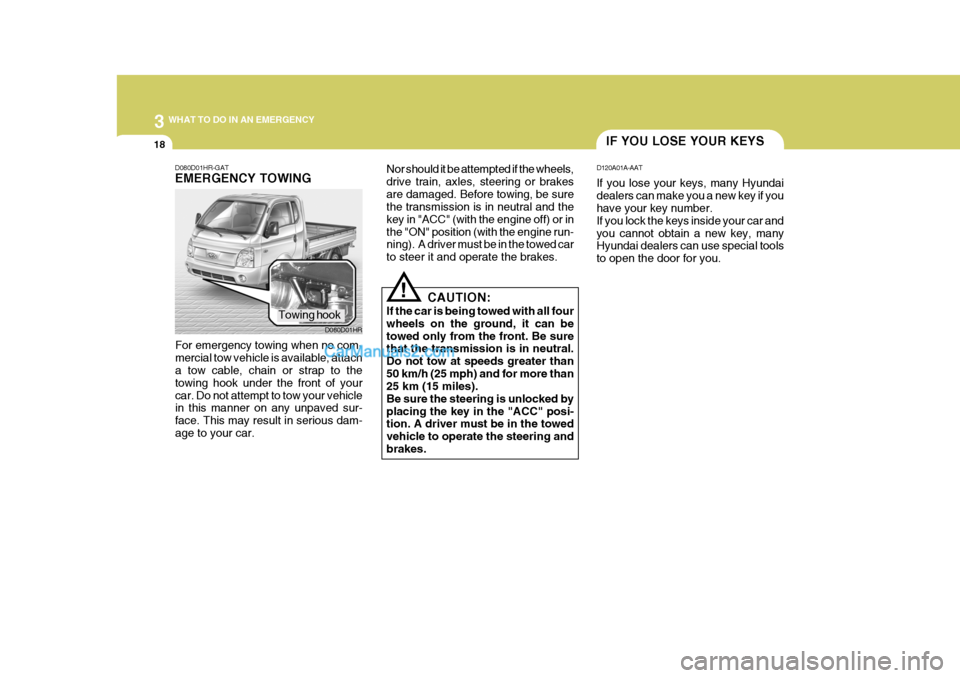
3 WHAT TO DO IN AN EMERGENCY
18IF YOU LOSE YOUR KEYS
D120A01A-AAT If you lose your keys, many Hyundai dealers can make you a new key if you have your key number. If you lock the keys inside your car andyou cannot obtain a new key, many Hyundai dealers can use special tools to open the door for you.
Nor should it be attempted if the wheels,drive train, axles, steering or brakesare damaged. Before towing, be sure the transmission is in neutral and the key in "ACC" (with the engine off) or inthe "ON" position (with the engine run- ning). A driver must be in the towed car to steer it and operate the brakes.
CAUTION:
If the car is being towed with all four wheels on the ground, it can be towed only from the front. Be sure that the transmission is in neutral. Do not tow at speeds greater than50 km/h (25 mph) and for more than 25 km (15 miles). Be sure the steering is unlocked byplacing the key in the "ACC" posi- tion. A driver must be in the towed vehicle to operate the steering andbrakes.
!
D080D01HR-GAT EMERGENCY TOWING
For emergency towing when no com- mercial tow vehicle is available, attach a tow cable, chain or strap to the towing hook under the front of yourcar. Do not attempt to tow your vehicle in this manner on any unpaved sur- face. This may result in serious dam-age to your car. D080D01HR
Towing hook
Page 134 of 217
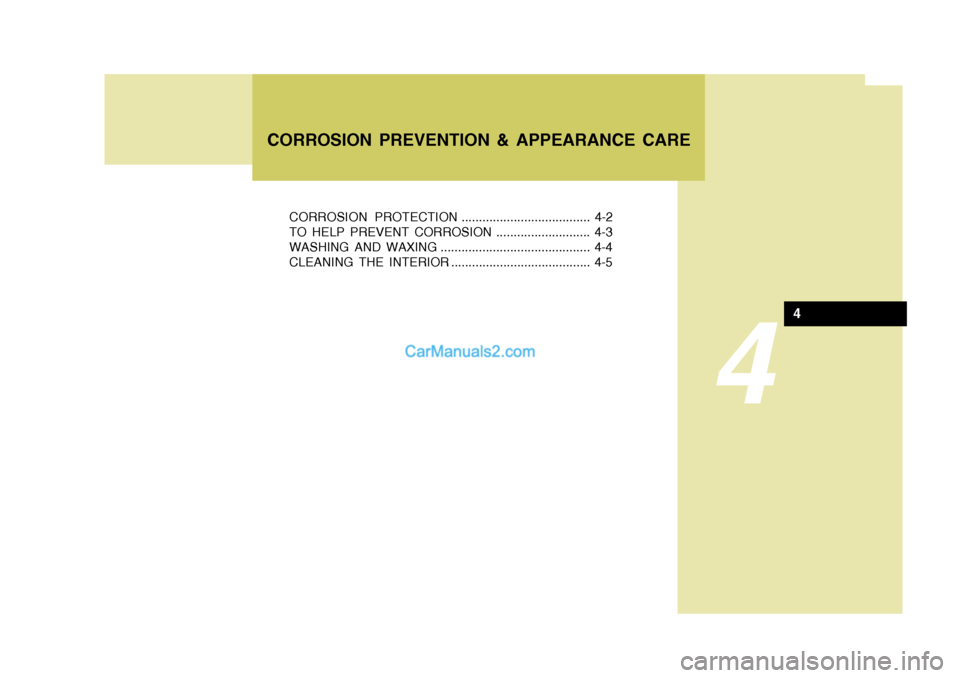
4
CORROSION PROTECTION ..................................... 4-2
TO HELP PREVENT CORROSION ........................... 4-3
WASHING AND WAXING ........................................... 4-4
CLEANING THE INTERIOR ........................................ 4-5
CORROSION PREVENTION & APPEARANCE CARE
4
Page 135 of 217
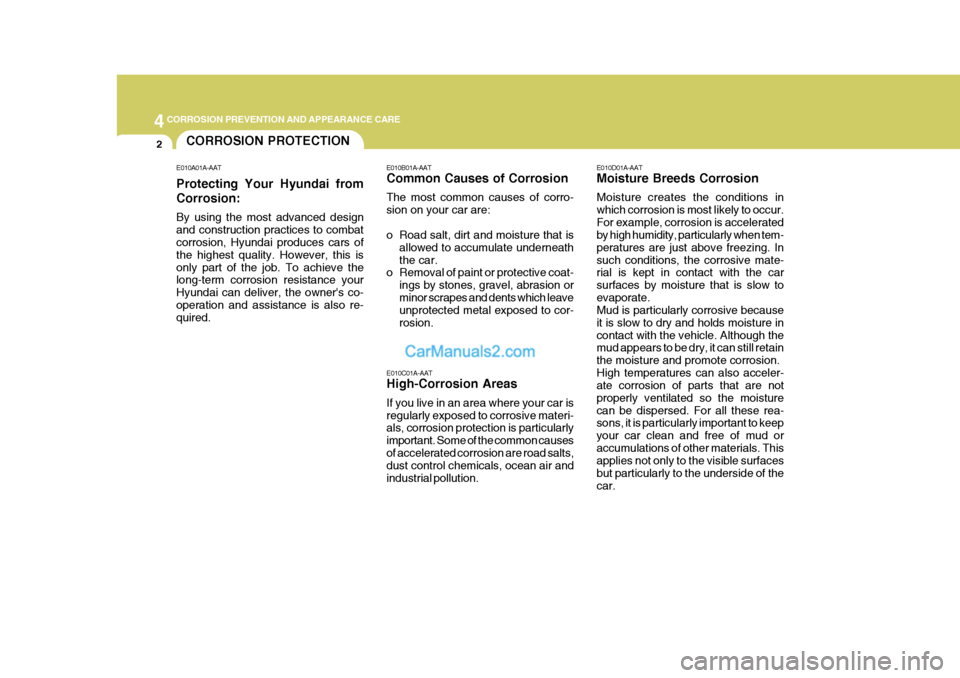
44CORROSION PREVENTION AND APPEARANCE CARE
2CORROSION PROTECTION
E010A01A-AAT Protecting Your Hyundai from Corrosion: By using the most advanced design and construction practices to combat corrosion, Hyundai produces cars of the highest quality. However, this isonly part of the job. To achieve the long-term corrosion resistance your Hyundai can deliver, the owner's co-operation and assistance is also re- quired.
E010C01A-AAT High-Corrosion Areas If you live in an area where your car is regularly exposed to corrosive materi- als, corrosion protection is particularly important. Some of the common causesof accelerated corrosion are road salts, dust control chemicals, ocean air and industrial pollution.
E010B01A-AAT Common Causes of Corrosion The most common causes of corro- sion on your car are:
o Road salt, dirt and moisture that is
allowed to accumulate underneath the car.
o Removal of paint or protective coat-
ings by stones, gravel, abrasion orminor scrapes and dents which leave unprotected metal exposed to cor- rosion. E010D01A-AAT Moisture Breeds Corrosion Moisture creates the conditions in which corrosion is most likely to occur.For example, corrosion is accelerated by high humidity, particularly when tem- peratures are just above freezing. Insuch conditions, the corrosive mate- rial is kept in contact with the car surfaces by moisture that is slow toevaporate. Mud is particularly corrosive because it is slow to dry and holds moisture incontact with the vehicle. Although the mud appears to be dry, it can still retain the moisture and promote corrosion.High temperatures can also acceler- ate corrosion of parts that are not properly ventilated so the moisturecan be dispersed. For all these rea- sons, it is particularly important to keep your car clean and free of mud oraccumulations of other materials. This applies not only to the visible surfaces but particularly to the underside of thecar.
Page 136 of 217
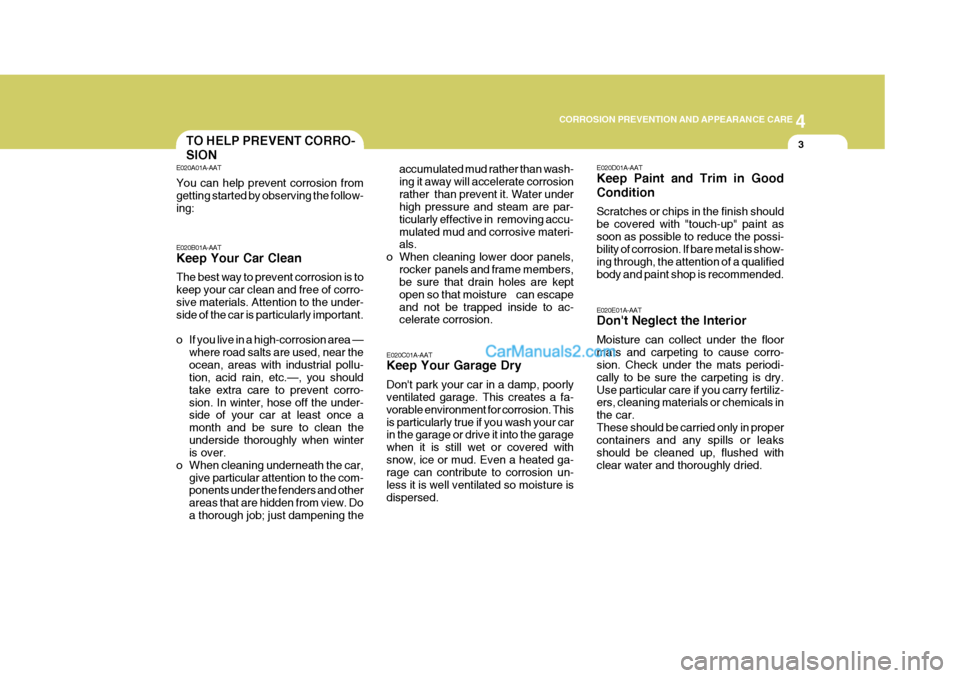
4
CORROSION PREVENTION AND APPEARANCE CARE
3
4
CORROSION PREVENTION AND APPEARANCE CARE
3TO HELP PREVENT CORRO- SION
E020C01A-AAT Keep Your Garage Dry Don't park your car in a damp, poorly ventilated garage. This creates a fa- vorable environment for corrosion. Thisis particularly true if you wash your car in the garage or drive it into the garage when it is still wet or covered withsnow, ice or mud. Even a heated ga- rage can contribute to corrosion un- less it is well ventilated so moisture isdispersed. E020D01A-AAT Keep Paint and Trim in Good Condition Scratches or chips in the finish should be covered with "touch-up" paint assoon as possible to reduce the possi- bility of corrosion. If bare metal is show- ing through, the attention of a qualifiedbody and paint shop is recommended. E020E01A-AAT Don't Neglect the Interior Moisture can collect under the floor mats and carpeting to cause corro- sion. Check under the mats periodi- cally to be sure the carpeting is dry.Use particular care if you carry fertiliz- ers, cleaning materials or chemicals in the car.These should be carried only in proper containers and any spills or leaks should be cleaned up, flushed withclear water and thoroughly dried.
E020B01A-AAT Keep Your Car Clean The best way to prevent corrosion is to keep your car clean and free of corro- sive materials. Attention to the under- side of the car is particularly important.
o If you live in a high-corrosion area —
where road salts are used, near the ocean, areas with industrial pollu- tion, acid rain, etc.—, you should take extra care to prevent corro-sion. In winter, hose off the under- side of your car at least once a month and be sure to clean theunderside thoroughly when winter is over.
o When cleaning underneath the car, give particular attention to the com-ponents under the fenders and other areas that are hidden from view. Doa thorough job; just dampening the accumulated mud rather than wash-ing it away will accelerate corrosionrather than prevent it. Water under high pressure and steam are par- ticularly effective in removing accu-mulated mud and corrosive materi- als.
o When cleaning lower door panels,
rocker panels and frame members,be sure that drain holes are kept open so that moisture can escapeand not be trapped inside to ac- celerate corrosion.
E020A01A-AAT You can help prevent corrosion from getting started by observing the follow- ing:
Page 137 of 217
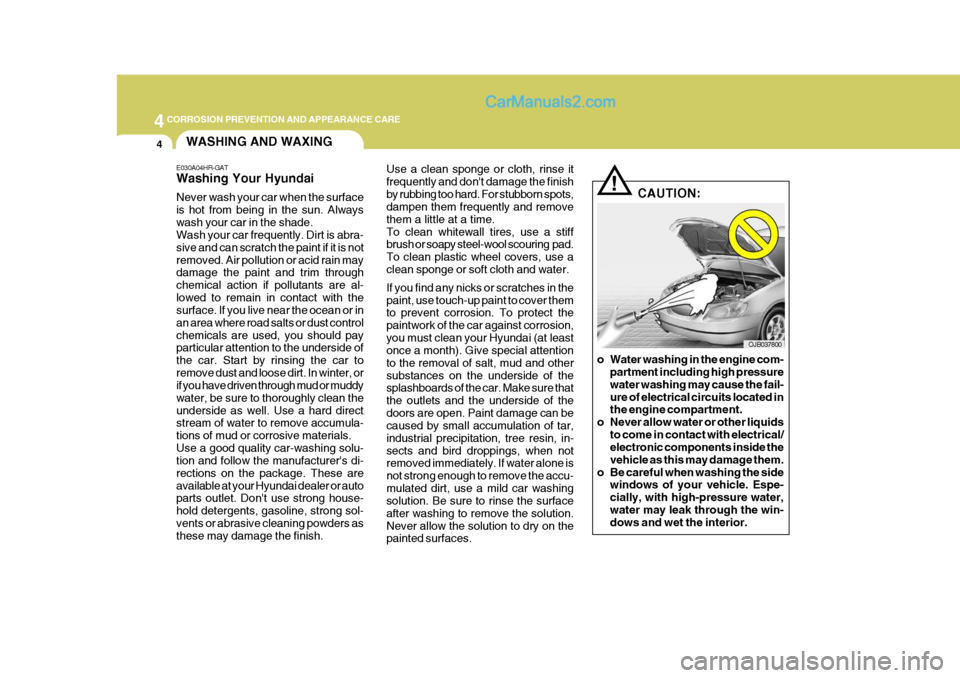
44CORROSION PREVENTION AND APPEARANCE CARE
4WASHING AND WAXING
E030A04HR-GAT Washing Your Hyundai Never wash your car when the surface is hot from being in the sun. Alwayswash your car in the shade. Wash your car frequently. Dirt is abra- sive and can scratch the paint if it is notremoved. Air pollution or acid rain may damage the paint and trim through chemical action if pollutants are al-lowed to remain in contact with the surface. If you live near the ocean or in an area where road salts or dust controlchemicals are used, you should pay particular attention to the underside of the car. Start by rinsing the car toremove dust and loose dirt. In winter, or if you have driven through mud or muddy water, be sure to thoroughly clean theunderside as well. Use a hard direct stream of water to remove accumula- tions of mud or corrosive materials.Use a good quality car-washing solu- tion and follow the manufacturer's di- rections on the package. These areavailable at your Hyundai dealer or auto parts outlet. Don't use strong house- hold detergents, gasoline, strong sol-vents or abrasive cleaning powders as these may damage the finish. Use a clean sponge or cloth, rinse it frequently and don't damage the finishby rubbing too hard. For stubborn spots, dampen them frequently and remove them a little at a time.To clean whitewall tires, use a stiff brush or soapy steel-wool scouring pad. To clean plastic wheel covers, use aclean sponge or soft cloth and water. If you find any nicks or scratches in the paint, use touch-up paint to cover them to prevent corrosion. To protect the paintwork of the car against corrosion,you must clean your Hyundai (at least once a month). Give special attention to the removal of salt, mud and othersubstances on the underside of the splashboards of the car. Make sure that the outlets and the underside of thedoors are open. Paint damage can be caused by small accumulation of tar, industrial precipitation, tree resin, in-sects and bird droppings, when not removed immediately. If water alone is not strong enough to remove the accu-mulated dirt, use a mild car washing solution. Be sure to rinse the surface after washing to remove the solution.Never allow the solution to dry on the painted surfaces.
CAUTION:
!
o Water washing in the engine com- partment including high pressure water washing may cause the fail-ure of electrical circuits located in the engine compartment.
o Never allow water or other liquids to come in contact with electrical/electronic components inside the vehicle as this may damage them.
o Be careful when washing the side windows of your vehicle. Espe-cially, with high-pressure water,water may leak through the win- dows and wet the interior.
OJB037800
Page 138 of 217
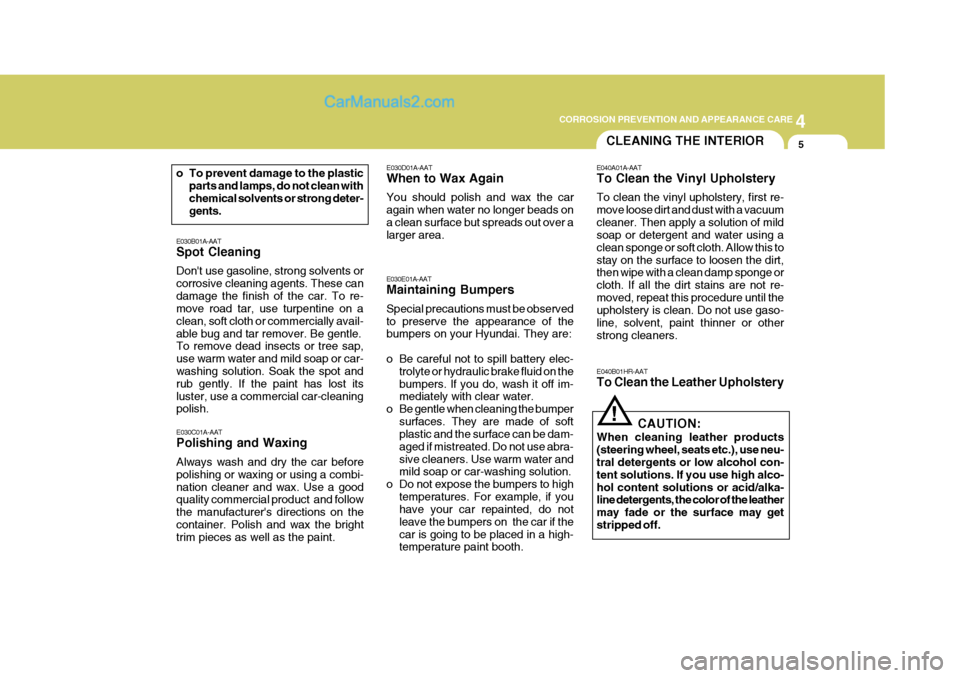
4
CORROSION PREVENTION AND APPEARANCE CARE
5
4
CORROSION PREVENTION AND APPEARANCE CARE
5
E030D01A-AAT When to Wax Again You should polish and wax the car again when water no longer beads ona clean surface but spreads out over a larger area. E030E01A-AAT Maintaining Bumpers Special precautions must be observed to preserve the appearance of the bumpers on your Hyundai. They are:
o Be careful not to spill battery elec- trolyte or hydraulic brake fluid on the bumpers. If you do, wash it off im- mediately with clear water.
o Be gentle when cleaning the bumper surfaces. They are made of softplastic and the surface can be dam- aged if mistreated. Do not use abra-sive cleaners. Use warm water and mild soap or car-washing solution.
o Do not expose the bumpers to high temperatures. For example, if youhave your car repainted, do not leave the bumpers on the car if thecar is going to be placed in a high- temperature paint booth.
E030B01A-AAT Spot Cleaning Don't use gasoline, strong solvents or corrosive cleaning agents. These candamage the finish of the car. To re- move road tar, use turpentine on a clean, soft cloth or commercially avail-able bug and tar remover. Be gentle. To remove dead insects or tree sap, use warm water and mild soap or car- washing solution. Soak the spot and rub gently. If the paint has lost itsluster, use a commercial car-cleaning polish.
E030C01A-AAT Polishing and Waxing Always wash and dry the car before polishing or waxing or using a combi-nation cleaner and wax. Use a good quality commercial product and follow the manufacturer's directions on thecontainer. Polish and wax the bright trim pieces as well as the paint.CLEANING THE INTERIOR
E040A01A-AAT To Clean the Vinyl Upholstery To clean the vinyl upholstery, first re- move loose dirt and dust with a vacuumcleaner. Then apply a solution of mild soap or detergent and water using a clean sponge or soft cloth. Allow this tostay on the surface to loosen the dirt, then wipe with a clean damp sponge or cloth. If all the dirt stains are not re-moved, repeat this procedure until the upholstery is clean. Do not use gaso- line, solvent, paint thinner or otherstrong cleaners. E040B01HR-AAT To Clean the Leather Upholstery
CAUTION:
When cleaning leather products (steering wheel, seats etc.), use neu- tral detergents or low alcohol con- tent solutions. If you use high alco-hol content solutions or acid/alka- line detergents, the color of the leather may fade or the surface may getstripped off.
!
o To prevent damage to the plastic
parts and lamps, do not clean with chemical solvents or strong deter- gents.
Page 139 of 217
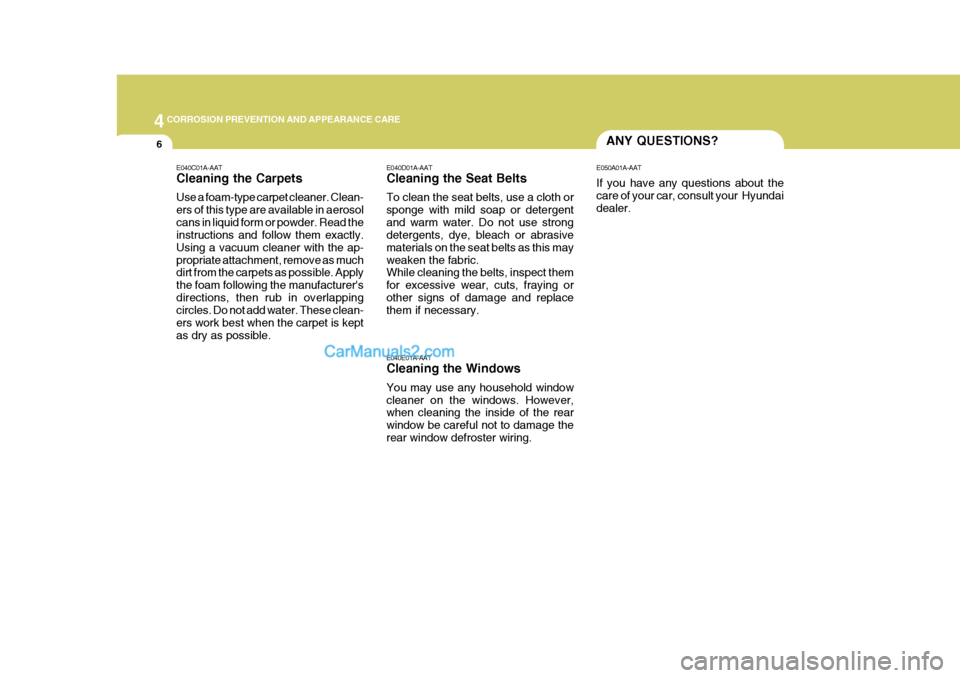
44CORROSION PREVENTION AND APPEARANCE CARE
6ANY QUESTIONS?
E040E01A-AAT Cleaning the Windows You may use any household window cleaner on the windows. However, when cleaning the inside of the rear window be careful not to damage therear window defroster wiring. E050A01A-AAT If you have any questions about the care of your car, consult your Hyundai dealer.
E040D01A-AAT Cleaning the Seat Belts To clean the seat belts, use a cloth or sponge with mild soap or detergentand warm water. Do not use strong detergents, dye, bleach or abrasive materials on the seat belts as this mayweaken the fabric. While cleaning the belts, inspect them for excessive wear, cuts, fraying orother signs of damage and replace them if necessary.
E040C01A-AAT Cleaning the Carpets Use a foam-type carpet cleaner. Clean- ers of this type are available in aerosolcans in liquid form or powder. Read the instructions and follow them exactly. Using a vacuum cleaner with the ap-propriate attachment, remove as much dirt from the carpets as possible. Apply the foam following the manufacturer'sdirections, then rub in overlapping circles. Do not add water. These clean- ers work best when the carpet is keptas dry as possible.
Page 140 of 217
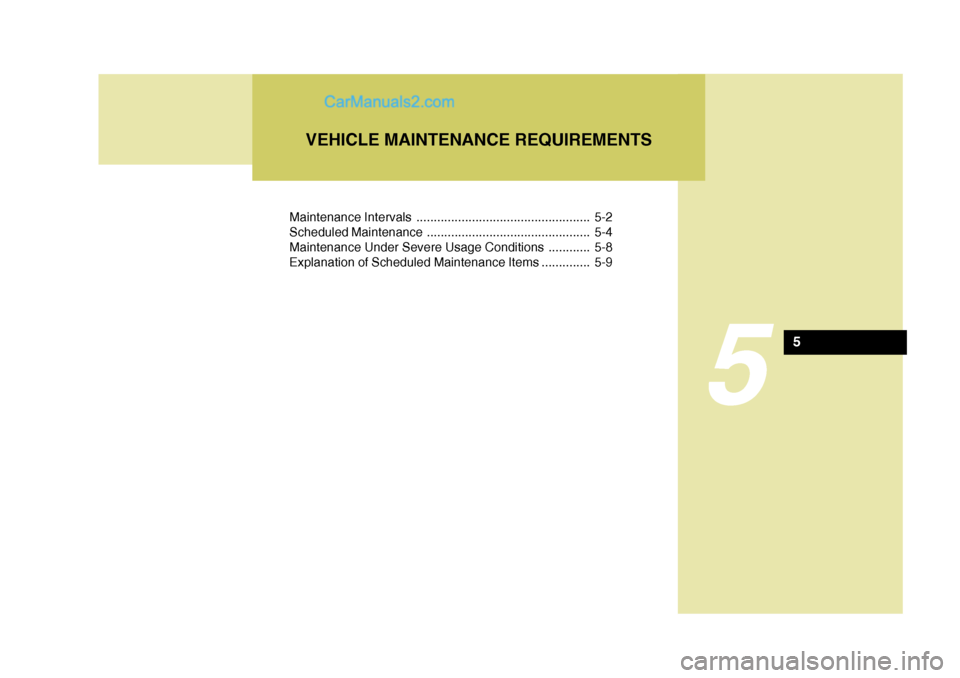
Maintenance Intervals .................................................. 5-2
Scheduled Maintenance ............................................... 5-4
Maintenance Under Severe Usage Conditions ............ 5-8
Explanation of Scheduled Maintenance Items .............. 5-9
5
VEHICLE MAINTENANCE REQUIREMENTS
5